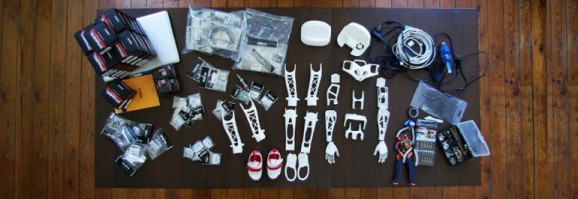3-D Printed Humanoid Robot Demonstrates Advances In Movement And Interaction
This article is more than 2 years old

Is it getting boring yet? 3-D printing just can’t and won’t stop making news. At this point there’s clearly not much 3-D printing can’t do, but at the same time, I never cease being amazed. Learning about Poppy, a new 3-D printed robot, is no exception. Poppy (those of us in Boston might call him Little Papi) is facilitating studies in bipedal walking, as well as human-robot interaction.
Flowers Laboratory (FLOWing Epigenetic Robots and Systems), a French research group that focuses on robotics, designed, printed, and constructed Poppy for just over $10,000, which is relatively cheap, especially given that includes all the servos and motors. Poppy, who runs on Raspberry Pi, is just shy of three feet tall, weighs 7.7 pounds, and has 16 sensory resistors, a microphone, two HD cameras, an LCD screen face that can register emotion, and the ability to measure its own inertia. They’ll also be making the Poppy’s design open source.

Flowers Lab wanted to build its own robot rather than use an existing model because they wanted to adopt some unconventional design aspects, especially concerning its ability to move more like a living creature. To that end, Poppy’s spin has five motors, far more than robots that size usually have. The articulated spine creates a more natural sense of movement, including the ability to adjust posture and balance. Poppy currently needs a little human guidance to walk (apparently it likes to hold hands), so the flexibility afforded by the spine helps it respond appropriately to that human contact.

Poppy also has springs in his leg joints to create tension that helps keep his non-stepping leg straight without relying on the use of motors. One of its more unusual aspects is that Poppy’s upper thighs bend inward at a six-degree angle, which narrows the distance between its feet and allows for greater balance and stability. The Flower folks actually made two Poppies — one with the usual straight thighs, and one with the aforementioned angled-in design to test their theories. Its feet are small and its toes can bend, so rather than the flat-footed, awkward gait of most robots, Poppy has a heel-to-toe walk. Poppy also sports an adorable pair of kid’s shoes that have pressure sensors on the soles.

The next step (ha ha — I hope Poppy has a sense of humor, especially given how many times I’ve accidentally typed its name as “Poopy”) is to get the robot walking without human assistance. So, you know, it can be of more human assistance itself.












